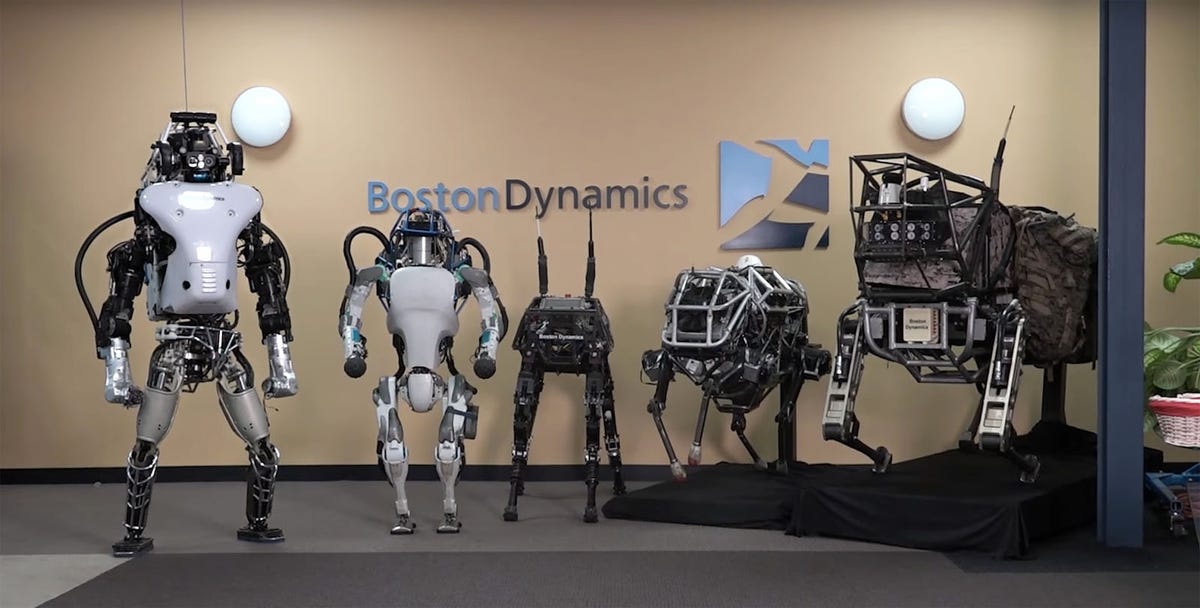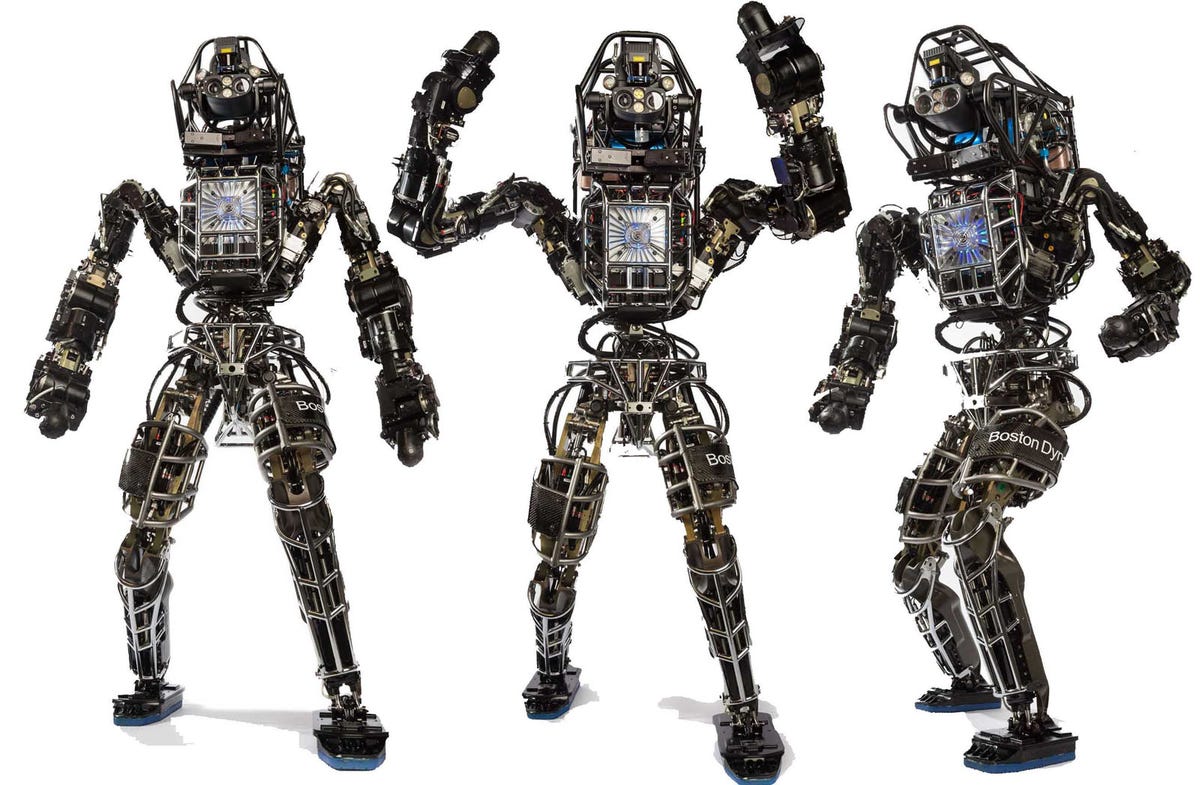The deadly, incredible and absurd robots of the US military
Mechanical animals. Strange android soldiers. They're real. And they're paid for with your tax dollars.

The strange robots of the US military
This year, the US Defense Advanced Research Projects Agency (DARPA) will spend nearly $3 billion to develop new military technologies. A huge chunk of that money will go to automation tech, including some absolutely incredible robot warriors.
Here are the most impressive battlefield robots that US taxpayer dollars have bought.

Atlas, the military's humanoid robot
Meet Atlas. Made by Boston Dynamics and funded by DARPA, the 6-foot-tall Atlas is the military's first serious, public effort toward developing a bipedal humanoid robot.
It's designed to perform some pretty incredible tasks.
Oops, robot fell down
The military wants Atlas to be proficient in a number of search and rescue tasks that include turning valves, opening doors and walking over rubble.
And it wants Atlas to do all of this without clumsily falling over, which, as this picture attests, is easier said than done.
Seriously, though. Atlas falls a lot
In 2015, DARPA held a robotics competition. The challenge: program an Atlas robot that can complete an eight-stage obstacle course. This particular entrant failed at the "open a door" phase.
Ever seen a robot drive a car?
When Atlas stays upright, though, it can do some pretty amazing things. In this photo, an Atlas programmed by IHMC Robotics drives a utility vehicle during the 2015 DARPA Robotics Challenge.
Atlas, The Next Generation
Of course, clumsy robots are so 2015. An upgraded version of Boston Dynamic's bot, epically named "Atlas, The Next Generation," was unveiled in 2016.
Atlas, The Next Generation uses laser imaging (LIDAR), stereo sensors in its head, and more sensors in its limbs to aid with balance and movement. As such, it's a lot less clumsy than the first-generation Atlas, even in snowy test conditions.
A 3D-printed robot
In creating the new Atlas, Boston Dynamics used 3D printing to embed hydraulics in its structure, custom tailoring parts to be smaller and more lightweight. As a result, Atlas, The Next Generation stands 5 feet 9 inches (1.8 metres) tall and weighs just 180 pounds (82 kilograms).
A robot with a grenade launcher
Not all US military robots carry weaponry but this, the Talon Swords, sure does. It's armed with a six-barrel, 40 mm grenade launcher. Other weapons options for the Talon include an M16 rifle, M240 machine gun and M202A1 Flash incendiary rocket launcher.
Talon robots were deployed in Iraq in 2007, though their weapon systems were never used.
The best defense against IEDs
Talon robots aren't all about offense; the tech is key in dealing with roadside bombs and other improvised explosive devices.
The Talon's seven cameras (including thermal- and night-vision) and long-range shield its operator from threat, allowing them to safely identify bombs from as far as 1,000 meters away. Remote-controlled Talons also assisted in the 9/11 recovery effort.
That's one way to test a robot's strength
The Talon is designed to cross snow, sand, water and drastically sloping terrain, with a top speed of about 5.2 miles per hour (8 km/hr). It's strong, too, with a towing capacity of nearly 750 pounds (340 kg).
"We always demonstrate its strength by having the Talon IV latch onto a soldier's gear and pull a prone soldier through a few lanes," Army Sgt. 1st Class Rocky Duran said.
The next generation of heavily armed robots
This is the successor to the armed Talon Swords robot, the Modular Advanced Armed Robotic System (MAARS), currently in testing. Like the Talon, MAARS has both lethal (machine guns, high explosives) and non-lethal modules (warning sirens, tear gas).
The US Army is hoping to have the 370-pound (167 kg) bots see action within the next few years.
On patrol with a killer robot
Per the Department of Defense, MAARS robots cannot make an autonomous decision to use lethal force. Only nearby human pilots can make that call.
The idea is to limit collateral damage, as the robot's bullets travel much further than its sensors can detect.
Field testing the MAARS
The Marine Corps has been researching the use of MAARS to provide extra firepower -- and thus, better protection -- for foot patrols.
Loaded with a M240B machine gun holding 450 rounds and four M203 Grenade Launchers on a 360-degree turret, MAARS is more than up to the task.
Building the BigDog
Boston Dynamic's BigDog, seen here, is arguably the most infamous DARPA robot. The 3-foot-long (92 centimeters), 2.5-foot-tall (76 cm) robot animal was designed to traverse challenging terrain while carrying a 340-pound load (154 kg).
BigDog: Too loud for service
While BigDog was able to cross snowy hills, rubble, coastal terrain and more with skill, the project was discontinued in December 2015 when it was ruled too noisy to use in combat.
LS3: A bigger, better sequel
This is the LS3, Boston Dynamic's successor to the BigDog. It's something of a robotic pack mule, designed to operate through human voice command. It can follow a soldier while carrying up to 400 pounds (180 kg) of equipment.
LS3 prototypes can run as fast as 7 miles per hour (11 km/hr) on flat surfaces, or between 1 and 3 miles per hour on rough terrain (2-5 km). It's also capable of righting itself without human assistance.
The LS3, up close
Despite investing $42 million in developing the LS3, the US Marine Corp decided to shelve the project at the end of 2015 because, like the BigDog, the LS3 was just too noisy.
"They took it as it was," Marine Corps Warfighting Lab spokesperson Kyle Olsen told military.com. "A loud robot that's going to give away their position."
Military robots in World War II
Remote-controlled battle robots date back to World War II. In that conflict, Germany used Goliath tracked mines, which were 820-pound (370 kg), 5-foot-long (1.5 meter) mini-tanks designed to hold large amounts of explosives.
The tech had an easily exploited weakness, however. Cutting the 650-meter-long command cable that connects the bot to its operator rendered it useless.
The USSR's first robo-tank
The USSR, too, developed its own unmanned weapons in the 1930s and '40s. The TT-38 teletank (right) was a radio-controlled assault vehicle piloted by a human inside a TU-38 (left) up to 1,500 meters away.
There were at least two Soviet teletank battalions fighting on the Eastern Front of World War II.

